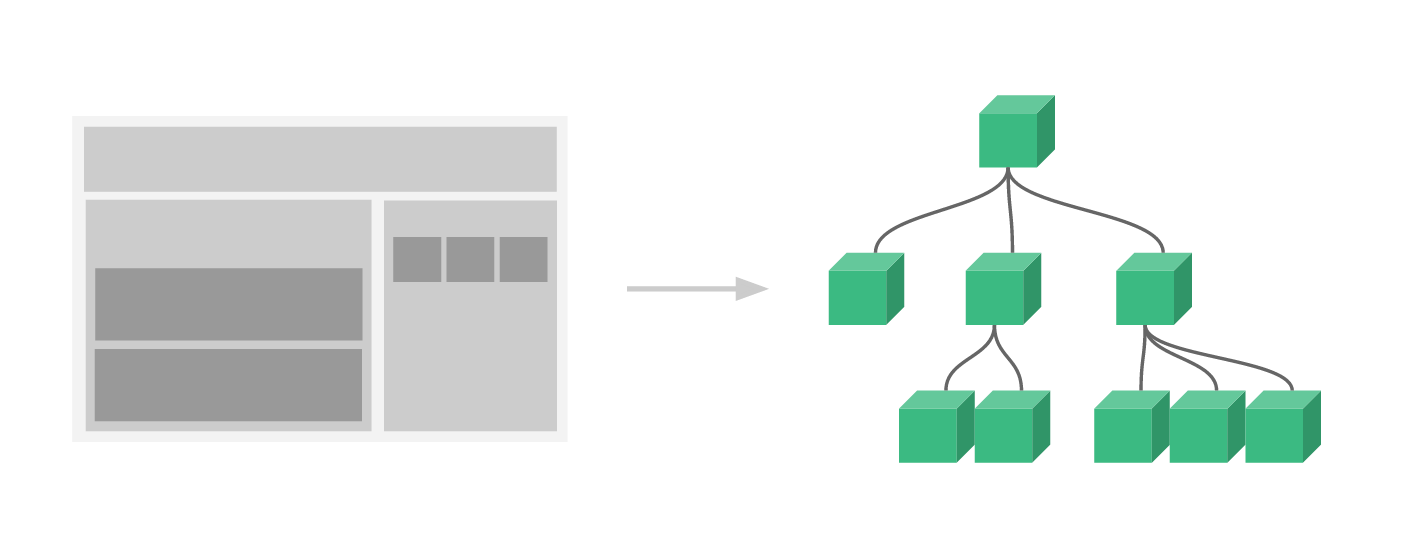[TOC]
>[success] # 組件的定義及復用性,局部組件和全局組件

上圖,**左面** 是 **頁面** 的 **整體結構** ,我們可以把它 **拆分成 3 個部分** ,**頭部** 、 **左側部分** 、 **右側部分** ,每個部分可以**再進行拆分** , 這樣我們就會發現一個頁面可以進行 **層層拆分** ,拆成一個像 **右側** 一樣的 **樹狀結構** ,這就是 **拆分組件的思維** 。
>[success] ## 組件復用性
**組件具備共用性(復用性),每個組件的數據是獨享的,而不會跟其他組件共享** , **組件在頁面多次引用 ,它們的數據不會共享,每個組件都是獨立的**
>[success] ## 全局組件
**全局組件名稱** :建議用小寫橫線連接(例如:counter-parent)
我們可以看到下面的代碼中, **counter-parent組件** 與 **counter 組件** 是兄弟級組件,那為什么在 **counter-parent組件** 中又可以引用 **counter 組件** 呢, 這是因為用 **app.component 方法定義的組件都會成為全局組件** ,在哪里都可以使用。
**缺點** : **如果定義了組件但是頁面中未引用該組件的標簽元素,這個組件會占用這個app實例化對象的存儲空間,一直掛載在這個app實例化對象上** ,所以說它對性能是有一定的損耗的,你不用它,它也在。
**index.html**
~~~
<!DOCTYPE html>
<html lang="en">
<head>
<meta charset="UTF-8">
<meta name="viewport" content="width=device-width, initial-scale=1.0">
<title>組件的定義及復用性,局部組件和全局組件</title>
<!-- 通過cdn方式引入vue -->
<script src="https://unpkg.com/vue@next"></script>
</head>
<body>
<div id="root"></div>
</body>
<script>
// 父組件
const app = Vue.createApp({
template: `
<div>
<counter-parent />
<counter />
<counter />
<counter />
</div>`
})
// 定義全局組件
app.component('counter-parent', {
template: `<counter />`
})
// 定義全局組件
app.component('counter', {
data(){
return {
count: 1
}
},
template: `<div @click="count += 1">{{count}}</div>`
})
const vm = app.mount('#root')
</script>
</html>
~~~
>[success] ## 局部組件
**局部組件名稱** :建議用 **大駝峰命名(例如:Name)**
**index.html**
~~~
<!DOCTYPE html>
<html lang="en">
<head>
<meta charset="UTF-8">
<meta name="viewport" content="width=device-width, initial-scale=1.0">
<title>組件的定義及復用性,局部組件和全局組件</title>
<!-- 通過cdn方式引入vue -->
<script src="https://unpkg.com/vue@next"></script>
</head>
<body>
<div id="root"></div>
</body>
<script>
// 1. 創建局部組件(局部組件建議首字母大寫)
const Counter = {
data(){
return {
count: 1
}
},
template: `<div @click="count += 1">{{count}}</div>`
}
// 父組件
const app = Vue.createApp({
components: { // 2. 引入局部組件
// Counter: Counter // 組件名:組件值
// 簡寫:
Counter
},
template: `
<div>
<counter />
</div>`
})
const vm = app.mount('#root')
</script>
</html>
~~~
- vue 26課
- Vue-cli3.0項目搭建
- Vue-ui 創建cli3.0項目
- Vue-ui 界面詳解
- 項目目錄詳解
- public文件夾
- favicon.ico
- index.html
- src文件夾
- api文件夾
- assets文件夾
- components文件夾
- config文件夾
- directive文件夾
- lib文件夾
- mock文件夾
- mock簡明文檔
- router文件夾
- store文件夾
- views文件夾
- App.vue
- main.js
- .browserslistrc
- .editorconfig
- .eslintrc.js
- .gitignore
- babel.config.js
- package-lock.json
- package.json
- postcss.config.js
- README.en.md
- README.md
- vue.config.js
- Vue Router
- 路由詳解(一)----基礎篇
- 路由詳解(二)----進階篇
- Vuex
- Bus
- Vuex-基礎-state&getter
- Vuex-基礎-mutation&action/module
- Vuex-進階
- Ajax請求
- 解決跨域問題
- 封裝axios
- Mock.js模擬Ajax響應
- 組件封裝
- 從數字漸變組件談第三方JS庫使用
- 從SplitPane組件談Vue中如何【操作】DOM
- 渲染函數和JSX快速掌握
- 遞歸組件的使用
- 登陸/登出以及JWT認證
- 響應式布局
- 可收縮多級菜單的實現
- vue雜項
- vue遞歸組件
- vue-cli3.0多環境打包配置
- Vue+Canvas實現圖片剪切
- vue3系統入門與項目實戰
- Vue語法初探
- 初學編寫 HelloWorld 和 Counter
- 編寫字符串反轉和內容隱藏功能
- 編寫TodoList功能了解循環與雙向綁定
- 組件概念初探,對 TodoList 進行組件代碼拆分
- Vue基礎語法
- Vue 中應用和組件的基礎概念
- 理解 Vue 中的生命周期函數
- 常用模版語法講解
- 數據,方法,計算屬性和偵聽器
- 樣式綁定語法
- 條件渲染
- 列表循環渲染
- 事件綁定
- 表單中雙向綁定指令的使用
- 探索組件的理念
- 組件的定義及復用性,局部組件和全局組件
- 組件間傳值及傳值校驗
- 單向數據流的理解
- Non-Props 屬性是什么
- 父子組件間如何通過事件進行通信
- 組件間雙向綁定高級內容
- 使用匿名插槽和具名插槽解決組件內容傳遞問題
- 作用域插槽
- 動態組件和異步組件
- 基礎語法知識點查缺補漏
- Vue 中的動畫
- 使用 Vue 實現基礎的 CSS 過渡與動畫效果
- 使用 transition 標簽實現單元素組件的過渡和動畫效果
- 組件和元素切換動畫的實現
- 列表動畫
- 狀態動畫
- Vue 中的高級語法
- Mixin 混入的基礎語法
- 開發實現 Vue 中的自定義指令
- Teleport 傳送門功能
- 更加底層的 render 函數
- 插件的定義和使用
- 數據校驗插件開發實例
- Composition API
- Setup 函數的使用
- ref,reactive 響應式引用的用法和原理
- toRef 以及 context 參數
- 使用 Composition API 開發TodoList
- computed方法生成計算屬性
- watch 和 watchEffect 的使用和差異性
- 生命周期函數的新寫法
- Provide,Inject,模版 Ref 的用法
- Vue 項目開發配套工具講解
- VueCLI 的使用和單文件組件
- 使用單文件組件編寫 TodoList
- Vue-Router 路由的理解和使用
- VueX 的語法詳解
- CompositionAPI 中如何使用 VueX
- 使用 axios 發送ajax 請求
- Vue3.0(正式版) + TS
- 你好 Typescript: 進入類型的世界
- 什么是 Typescript
- 為什么要學習 Typescript
- 安裝 Typescript
- 原始數據類型和 Any 類型
- 數組和元組
- Interface- 接口初探
- 函數
- 類型推論 聯合類型和 類型斷言
- class - 類 初次見面
- 類和接口 - 完美搭檔
- 枚舉(Enum)
- 泛型(Generics) 第一部分
- 泛型(Generics) 第二部分 - 約束泛型
- 泛型第三部分 - 泛型在類和接口中的使用
- 類型別名,字面量 和 交叉類型
- 聲明文件
- 內置類型
- 總結
